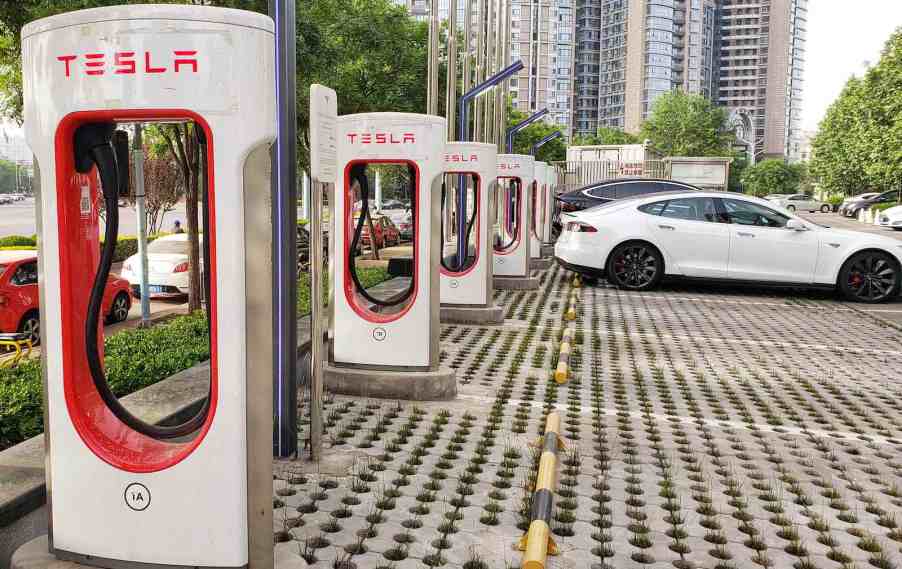
Tesla’s Charging Network Could Have Been Its $12 Billion Goldmine–but Elon Musk Killed It
There’s an old story business people love to tell: The first millionaire in the 1849 California gold rush wasn’t a miner. He was a store owner who had the foresight to buy up every pick and shovel he could, then resold them at a hefty markup.
It seems as if a new electric vehicle startup pops up every week. Many have faded into bankruptcy as quickly as they first exploded into popularity. But while these “miners” fight out who gets a nugget of the EV gold rush, it may be the charging network owners who make the first fortune. Tesla was uniquely positioned to be one of them, whether or not it holds onto its share of the auto market. But not anymore.
Tesla’s first production car was the 2008 Roadster. You could plug the little sports car in at home, and it charged up overnight. But what happened when you maxed out its 245 mile range? By 2012, it became clear that a robust public charging network was critical to EV adoption. So in September 2012, Tesla installed its first public chargers.

Now, at that point there was no standard public charger plug. So Tesla invented its own. As other automakers began to build EVs, they agreed on a plug that didn’t work with Tesla. The upside was that Tesla owners didn’t have to wait in line at their proprietary public chargers.
Soon, the Tesla “supercharger” network became so large, that it was a major selling point of the vehicles. For example, the current Hyundais are hypothetically capable of charging twice as fast. But when I pitted a Tesla Model 3 against a Hyundai Ioniq 5 on a simulated cross-country roadtrip, I found you’d spend less time charging and more time driving in the Tesla. The Hyundai could do 4.76 minutes of driving for every minute of charging, but the Model 3 could do 7.75 minutes of driving time for every one minute on a charger.
With over 17,000 individual fast-charging ports, Tesla’s network is many times larger than its nearest competitor (3,600). But with new federal funding, the competition is catching up quickly.

Then everything changed. The SAE classified the Tesla Supercharger plug as the North American Charging Standard (NACS) and created a spec sheet so any automaker could build cars that worked with it. And one-by-one, every automaker agreed to make its EVs compatible with Tesla chargers.
This shift has–understandably–gotten investors even more excited about Tesla. Because most EV charging happens at home, public charging will never be as big a business as gas stations. But AutoForceast Solutions still predicted Tesla will see $6 billion to $12 billion in annual revenue from its chargers by 2030. The Motley Fool investment blog compared NACS to the moment when Amazon saw more income from its Amazon Web Services servers for other websites than from its own website. And of course Amazon stock is out of sight.
This past year, EV sales have slowed. I have my own theories on why, but it’s obvious that the lack of public fast chargers is making early adoption a real pain for some folks. As more people buy EVs, the approval rating of the public charging network has actually gone down. This may be because of long waits at chargers, or because an increasing number of EV buyers are seeking a hassle-free luxury vehicle. But as a result, one in five early adopters have went back to gasoline for their next vehicle purchase.

Tesla is seeing some of its worst, and longest running profit losses ever. The startup is in full on crisis mode, slashing the prices of its new models and also going through one round of layoffs after another. And in an especially dramatic move, Elon Musk just cut his entire public charging network team.
The head of Tesla’s “Supercharging Group” was Rebecca Tinucci. In just six years, she’s doubled the size of the company’s public charging network. She also oversaw the NACS changeover which unlocked federal funding for installing chargers, and the deals with every other EV maker to adopt Tesla’s plug. It’s unsurprising that Musk called her, “the driving force of the company.” So why did Musk just fire her and 500 people who work under her?
Some have argued that Musk was making an example of certain executives that were complaining of his 10%+ workforce layoff. He said in his companywide email, “Hopefully these actions are making it clear that we need to be absolutely hard-core about headcount and cost reduction…While some on exec staff are taking this seriously, most are not yet doing so.”
Others argue that Musk no longer sees the network as a competitive advantage: if it works with any car, it won’t boost Tesla sales. But the truth is that he is closing up his pick axe store to double down on his goldmine plot. And that mine may or may not pan out.
Next, read about the DOJ’s subpoena of Tesla, or learn more about the Supercharger Group layoffs in the video below:



